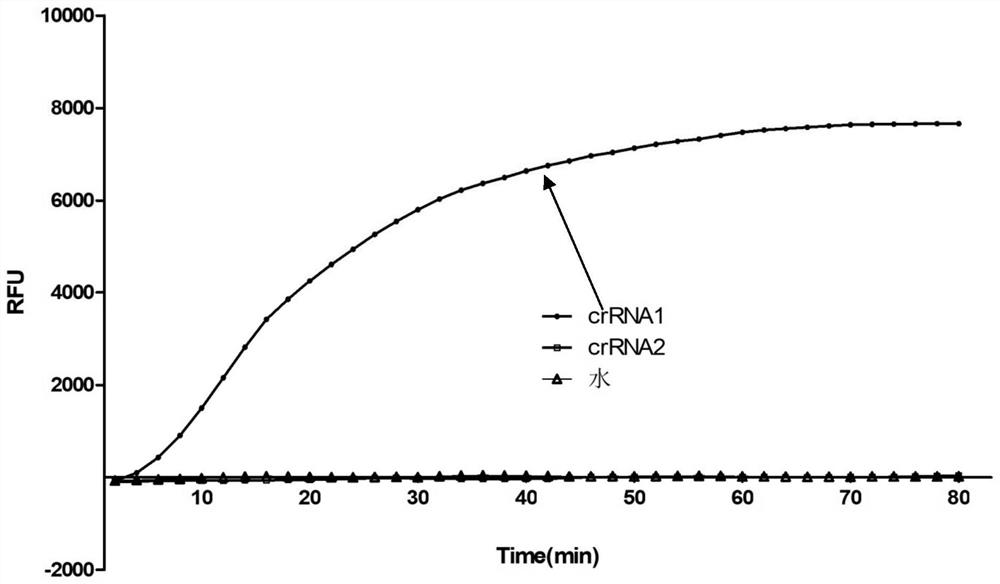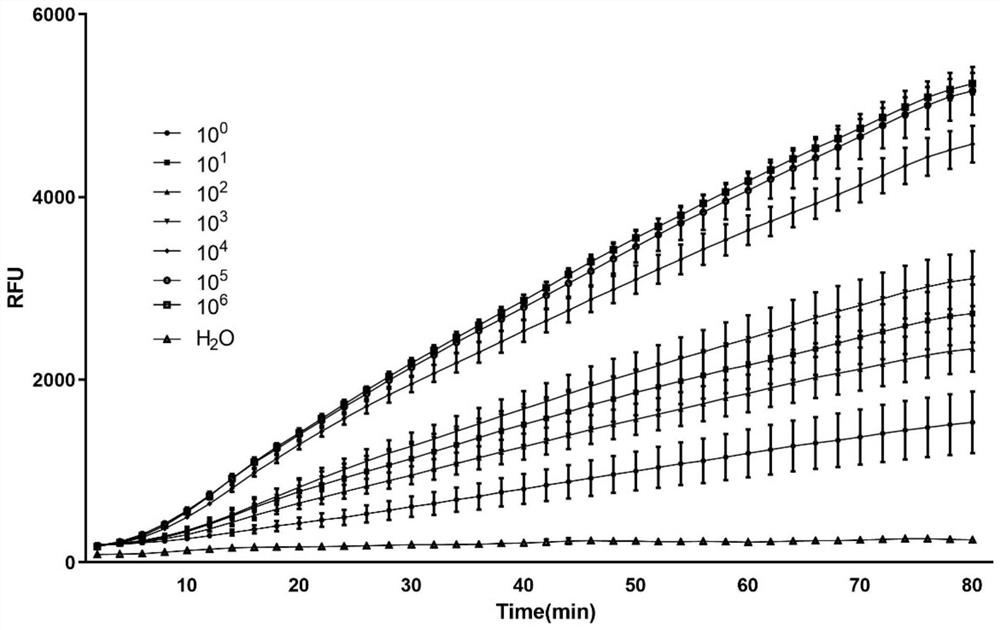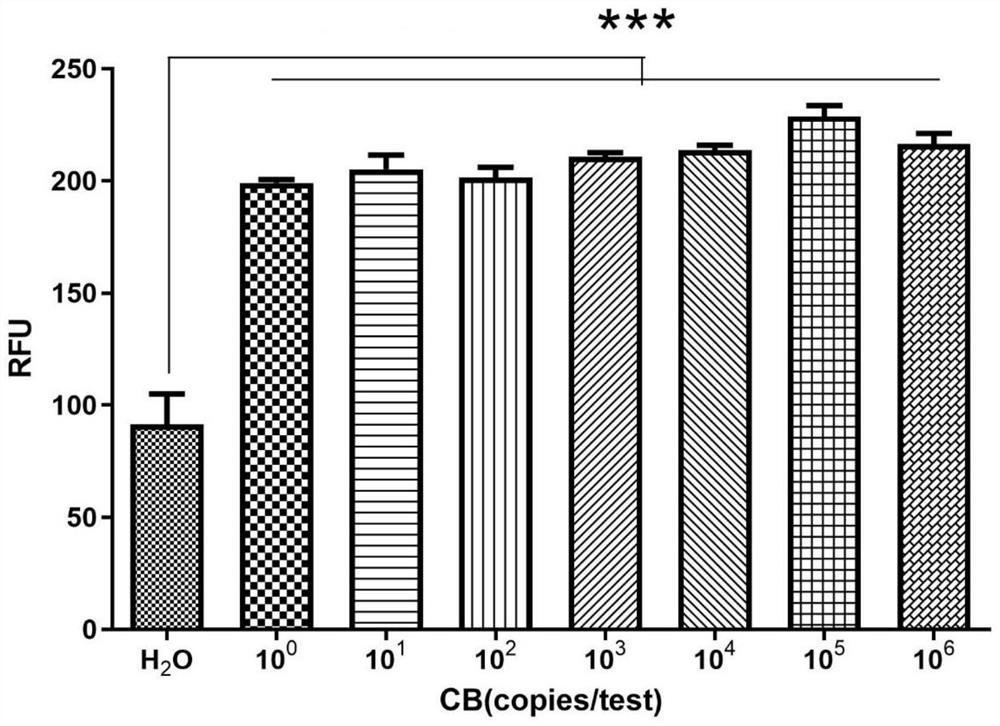CRISPR-Cas13a (Clustered Regularly Interspaced Short Palindromic Repeats-Cas13a) system for detecting coxiella burnetii nucleic acid
A technology of Coxiella basidioides and nucleic acid molecules, which is applied in the direction of microorganism-based methods, microorganism measurement/inspection, DNA/RNA fragments, etc., and can solve the problem of complex isolation operation, low efficiency, and ineffective detection of Rickettsia pathogens. Antibody and other issues, to achieve significant application promotion value, rapid and accurate detection effect
- Summary
- Abstract
- Description
- Claims
- Application Information
AI Technical Summary
Problems solved by technology
Method used
Image
Examples
Embodiment 1
[0042] Embodiment 1, the preparation of each component of kit
[0043] 1. Preparation of LwCas13a protein
[0044] For the expression, purification and activity identification of LwCas13a protein, refer to the method in the patent application document entitled "A crRNA target for detection of Ebola virus and CRISPR-Cas13a system" with publication number CN110628955. Specific steps are as follows:
[0045] 1. Induced expression, purification and identification of LwCas13a protein
[0046]The LwCas13a expression plasmid is PC013-Twinstrep-SUMO-huLwCas13a, obtained from the Addgene platform (https: / / www.addgene.org / search / catalog / plasmids / ?q=PC013-Twinstrep-SUMO-huLwCas13a). The LwCas13a expression plasmid expresses the LwCas13a protein shown in Sequence 8 of the Sequence Listing.
[0047] The LwCas13a expression plasmid was introduced into Escherichia coli Rosetta (DE3) competent cells, and then cultured in TB liquid medium at 37°C and 200rpm for more than 14 hours. Then tra...
Embodiment 2
[0065] Embodiment 2, the screening of optimal crRNA
[0066] The standard plasmid mother liquor prepared in Example 1 is diluted to make the plasmid concentration 10 6 copies / μL is the standard plasmid solution of Plasmid-Coxiella.
[0067] 1. RPA amplification
[0068] Using the Plasmid-Coxiella standard plasmid solution as a template solution, RPA amplification was performed to obtain RPA amplification products.
[0069] The RPA amplification system is shown in Table 1.
[0070] Prepare 47.5 μL of the system shown in Table 1, and add it into the basic reaction unit equipped with RPA freeze-dried powder, so that the freeze-dried powder is fully redissolved and even. Add 2.5 μL of 280 mM magnesium acetate solution to the cap of each reaction tube, close the cap and collect by centrifugation and mix well. Then place the reaction tube at 39° C. for 20-40 minutes to react.
[0071] 2. Detection of Coxella bainiella nucleic acid based on CRISPR-Cas13a system
[0072] The rea...
Embodiment 3
[0077] Embodiment 3, the establishment of the composition of kit and method
[0078] 1. The composition of the kit
[0079] The composition of the kit is as follows: the Cas13a protein prepared in Example 1, the crRNA-1 prepared in Example 1, the standard plasmid stock solution prepared in Example 1, the RPA amplification primers prepared in Example 1 (Coxiella-F and Coxiella-R ).
[0080] Second, the establishment of the method
[0081] 1. RPA amplification
[0082] Using the test DNA solution as the template solution, carry out RPA amplification to obtain the RPA amplification product.
[0083] The test DNA solution is a standard plasmid solution or a sample DNA solution.
[0084] The RPA amplification system is shown in Table 1.
[0085] Table 1 RPA amplification system
[0086]
[0087] Prepare the 47.5 μL system shown in Table 1, and add the basic reaction unit equipped with RPA freeze-dried powder (with nfo RPA amplification kit), the lyophilized powder was fu...
PUM
 Login to View More
Login to View More Abstract
Description
Claims
Application Information
 Login to View More
Login to View More - R&D
- Intellectual Property
- Life Sciences
- Materials
- Tech Scout
- Unparalleled Data Quality
- Higher Quality Content
- 60% Fewer Hallucinations
Browse by: Latest US Patents, China's latest patents, Technical Efficacy Thesaurus, Application Domain, Technology Topic, Popular Technical Reports.
© 2025 PatSnap. All rights reserved.Legal|Privacy policy|Modern Slavery Act Transparency Statement|Sitemap|About US| Contact US: help@patsnap.com



